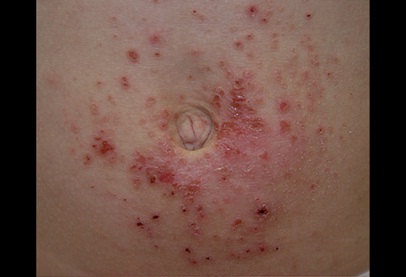Contact Dermatitis Causes, Symptoms, Diagnosis and Treatment

What Is Contact Dermatitis?
Contact dermatitis is a type of skin inflammation.
It is a red, itchy rash caused by a substance that comes into contact with the skin.
The rash isn’t contagious or life-threatening, but it can be very uncomfortable.
Types of contact dermatitis include:
- Irritant contact dermatitis
- Allergic contact dermatitis
- Occupational contact dermatitis
Causes Of Contact Dermatitis:
Contact dermatitis is caused by exposure to substances which trigger an allergic reaction.
The cause depends upon the type of contact dermatitis.
- Irritant contact dermatitis:
This occurs when a substance damages your skin’s outer protective layer.
Some common irritants include:
- Solvents
- Rubbing alcohol
- Bleach
- Personal care products, such as soaps, deodorants and cosmetics
- Airborne substances, such as sawdust or wool dust
- Burdock, a plant used in alternative medicine therapies
- Allergic contact dermatitis
Usually affecting the exposed area, allergic contact dermatitis occurs when a substance to which one is sensitive (allergen) to triggers an immune reaction in the skin.
Common Allergies Include:
- Nickel, which is used in:
- jewelry
- buckles
- Medications, such as:
- antibiotic creams
- oral antihistamines
- Balsam of Peru, used in products, such as :
- perfumes,
- cosmetics
- mouth rinses
- flavorings
- Formaldehyde, present in
- adhesives,
- solvents
- Personal care products, including:
- deodorants,
- body washes
- hair dyes
- cosmetics
- nail polish
- Skin tattooing and black henna
- Plants such as:
- poison ivy rash
- mango
- Airborne substances
Symptoms Of Contact Dermatitis:
People who develop contact dermatitis show the following signs and symptoms:
- Red rash or bumps
- Itching, which may be severe
- Dry, cracked, scaly skin, if your condition is chronic
- Blisters, draining fluid and crusting, if your reaction is severe
- Swelling, burning or tenderness
Diagnosis Of Contact Dermatitis:
Contact dermatitis can be diagnosed via thorough examination of signs and symptoms.
The following procedure is taken:
- Taking a medical history
- Doing a physical exam
- Performing a Patch test
Treatment Of Contact Dermatitis:
Treatment for contact dermatitis includes the following:
- Avoiding the irritant or allergen
- Applying prescription steroid cream
- Applying medications to repair the skin
- Using oral medications.
Related Articles:
Bursitis Causes, Symptoms, Diagnosis and Treatment
Folliculitis Causes, Symptoms, Diagnosis and Treatment
Carcinoid Syndrome Causes, Symptoms, Diagnosis and Treatment
Buerger’s Disease Causes, Symptoms, Diagnosis and Treatment
Shingles Symptoms, Causes, Diagnosis and Treatment
Chilblains Causes, Symptoms, Diagnosis and Treatment
Cradle Cap Causes, Symptoms, Diagnosis and Treatment
Cold Urticaria Causes, Symptoms, Diagnosis and Treatment
Henoch Schonlein Purpura (HSP) Causes, Symptoms, Diagnosis and Treatment
Soft Tissue Sarcoma Causes, Symptoms, Diagnosis and Treatment
Pilonidal Cyst Causes, Symptoms, Diagnosis and Treatment
Stevens-Johnson Syndrome Causes, Symptoms, Diagnosis and Treatment
By : Natural Health News




